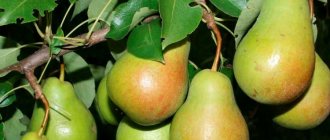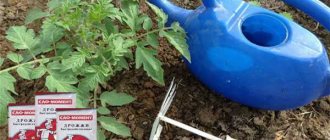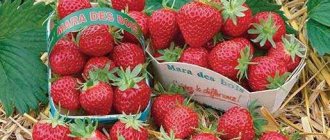Ostara is a variety of remontant garden strawberry. Ostara was bred in Holland by scientists from the agricultural company PRI. The variety was developed in the 70s. In order to obtain this garden strawberry, scientists used varieties such as:
- Redgauntlet.
- Macherauches.
Despite the fact that this variety is already 50 years old, it is still in good demand. Yes, in commercial production it cannot compete with modern varieties, but at the dachas of Russian gardeners, Ostara can be found, and quite often.
In this publication you will get to know the Dutch beauty in detail. In the article you will find a complete description of Ostara, learn reviews from gardeners about it, and also see photographs of a beautiful berry.
Description of the variety
Back in the distant sixties of the last century, Dutch breeders managed to develop the Ostara strawberry variety by crossing the Masherachs Daurernte and Red Gauntlet varieties.
Ostara strawberries are day neutral varieties. Even when cultivated in ordinary open-air beds, it will be able to bring you a harvest of wonderful berries from June until the first snow. Moreover, the autumn harvest is in no way inferior in taste to early berries, and may differ only in the size of the fruits in the direction of their reduction. But the yield of bushes can only increase by autumn, naturally, subject to regular watering and fertilizing throughout the growing season. Over the entire warm season, you can collect about 1.0-1.2 kg of fragrant and tasty strawberries from one bush. True, experts do not recommend leaving fruit-bearing bushes of this variety of strawberries for the next year, but replacing them with young plants. Because both the yield and the size of the berries next season may greatly disappoint you.
Ostara strawberry bushes have a fairly compact appearance and do not exceed 20-25 cm in height. The dark green, medium-sized leaves are covered with small hairs.
Attention! Flowering and, accordingly, the setting of berries occurs during the season not only on the mother bushes, but also on young plants formed on rooted tendrils.
The educational ability is average, depending on the regularity and composition of fertilizing. The more nitrogen component there is in the fertilizers used, the more tendrils and young rosettes will be formed. But this can negatively affect the yield and especially the taste of the berries. Therefore, you should not be overzealous with this.
Ostara strawberries are resistant to most fungal diseases, except gray rot. Therefore, in rainy weather, it is advisable to provide the berries with additional shelter, if possible.
Ostara bushes tolerate winter frosts well, but when grown in the northernmost regions, it is better to lightly cover the plants for the winter. Without shelter, it tolerates frosts down to -15°C. However, this is important only in regions with little snowy winters. Because Ostara strawberries overwinter well under a large, permanent layer of snow.
This variety tolerates hot conditions worse; at temperatures above +28°C, pollen can become sterile and the number of berries decreases sharply.
Characteristics of berries
Ostara strawberries have the following characteristics:
- The shape of the fruit is traditionally cone-shaped, the berries are attractive in appearance and have a shiny surface.
- The color of the berries is uniform bright red.
- Although Ostara strawberries belong to large-fruited varieties, their berries are rather medium in size - about 20-30 grams in weight each. In particularly favorable conditions, the weight of the berry can reach 60-70 grams.
- The berries are not dense, but they are very juicy.
- They are stored for a very short time and are practically unsuitable for transportation.
- But the taste can be called unique; it is very reminiscent of real wild strawberries. The aroma of the berries is also pronounced. In terms of taste, Ostara strawberries received 4.7 points on a five-point scale.
- The use of Ostara strawberries is universal, but they are most delicious when fresh.
Strawberry Ostara
Reviews
True, the main harvest takes place in June-July, but we also eat this berry in September. I like its taste and aroma. The aroma is reminiscent of strawberries, and the taste has a pronounced sweetness. The pulp is juicy, the berry is medium in size and quite fragile. I don’t transport such berries, they won’t survive transportation - either eat them or process them at the collection site.
Such varieties require abundant fertilizer because they bear fruit all the time, and the size of the berries depends on watering and fertilizing. That’s why I didn’t dare to grow such varieties before; I use little fertilizer and only organic fertilizer.
I don’t see any big advantages for this strawberry compared to regular varieties, except that it produces berries in September, but there aren’t many of them, you can just eat them.
Although the Ostara strawberry is a foreign variety, it has taken root in my Moscow region. The bushes are not large. The berries in the 1st year were medium and small, the taste was pleasant, I was especially pleased with the strawberry aroma of strawberries.
I like wild strawberries more than strawberries, but here it turns out like a large strawberry, although not as sweet. I liked the harvest of the 1st year, but in the 2nd year I received mostly small berries.
For me, it’s better to plant bushes once and collect berries from them for several years, but this variety is not like that - it needs to be renewed almost every year. It is not necessary to buy new seedlings; this strawberry produces a lot of tendrils that can be used as seedlings, and the excess tendrils can be removed.
Quite a hassle of care, but if you work with strawberries, you can pick them for a long time, even if they are not large ones. In addition to renewal and watering, strawberries need to be fertilized abundantly, covered for the winter, and if the summer is rainy, then the berries must be separated from the ground so that they are not affected by rot. The berry is delicate, can be easily deformed, it cannot be transported, but it is delicious to eat.
My experience in growing Ostara strawberries is only 2 years. Before that, I grew ordinary strawberry varieties with different ripening periods - early, middle and late. Then I decided to try to grow a remontant variety that bears fruit from late spring to late autumn and chose this variety as a sweet one. I planted the seedlings in the spring in a separate bed, the distance between the bushes is about 30 cm.
The taste of the berries of remontant varieties is not as rich and sweet as compared to regular ones, but this variety retains its sweetness and rich aroma. These strawberries were harvested every month until October, and the autumn berry was sweet. But in the 2nd year the berries grew smaller, and I learned that I need to renew the bushes as often as possible or the berries will be small.
While I’m eating this berry, the yield is falling, but next year I’ll have to develop new beds and grow new young plants.
I have conflicting impressions of Ostara strawberries. On the plus side, the variety is frost-resistant and well adapted to our climate. I have never had these strawberries affected by diseases. It's also not difficult to care for - regular watering, weeding, nothing complicated.
The variety bears fruit until autumn and the berries are quite tasty, especially in autumn, when there are no berries from other varieties of strawberries for a long time. The downside is that the berries quickly become smaller. My bushes degenerated after 2 years.
This berry is also fragile, and when it is small, it is especially difficult to separate it from the stalk, which it firmly holds on to - the berry easily crushes in your hands.
If the berry of this variety still reaches medium size, then it cannot be transported due to its fragility. And it doesn’t hold its shape well in the preparation, for example, when frozen or when making jam with whole berries. It is better to grind or cook compote from small berries.
I planted the Ostara variety to eat strawberries in the summer until September. Following all the recommendations for growing this variety, I strengthened and grew the bushes for one summer, and harvested berries for 2 years. It bears fruit for a long time, you need to constantly care for the garden bed and harvest regularly, but the harvest itself is small at one time and only for food, and there is not enough for harvesting.
The taste of the berry seemed mediocre to me - when the berry is small or in rainy weather, it is sour or watery, and I eat such a berry without pleasure. At the peak of ripeness and in sunny weather, this berry is sweet and sour, like a vitamin - it is healthy, but also not particularly tasty.
I leave 1 bed of these strawberries for variety, so that I can eat strawberries fresh from the bush until the fall, but I don’t want to grow them too much. There are varieties of larger strawberries, from which I make preparations, but this variety is too small.
a brief description of
Ostara is a remontant, productive variety, suitable for growing in open ground in the middle zone, which is quite harsh for strawberries. The taste is high, the berries are used raw and for making preserves and jams. What you should not do is freeze the fruits. After defrosting they don't hold their shape at all.
Advantages of the variety
- prolonged fruiting until frost;
- high productivity;
- rich strawberry aroma of berries with notes of wild strawberries;
- no dependence on daylight hours;
- unpretentiousness and undemandingness to soil and climate;
- high resistance to diseases.
Disadvantages of the variety
- small fruits;
- poor transportability and keeping quality of the crop.
Reviews from experienced gardeners
As a rule, all reviews for this variety of garden strawberries are very similar. For the most part, gardeners are satisfied with their purchase, but they warn about the need for careful care not only for the strawberries themselves, but also for the soil in which they grow. Remontant varieties are often characterized by not very high taste qualities, but Ostara strawberries stand out with a pronounced sweet taste, reminiscent of wild strawberries. All gardeners admire the almost continuous flowering and the rapid setting of many fruits. Very good for home planting. But there are also disadvantages:
- after one year the strawberries become very small;
- excessively soft fruits not suitable for transportation. This is why entrepreneurs are advised to choose a different variety for business;
- It is poorly stored and is prone to the formation of gray rot.
Save the article:
Landing
The strawberry bed with Ostara should be located only in a place well lit by the sun. If the plant does not get enough sunlight, the berries will be sour. Also, over time, the volume of the harvest will decrease, and the bushes themselves will develop poorly and produce little mustache.
Planting is done in spring or summer. Summer planting, carried out in late July - early August, is considered the most preferable, because the bushes will have time to take root and develop before frost, and the next season they will actively bear fruit.
Ostara bushes should be planted at a distance of 25-30 cm from each other in a row, maintaining a distance between rows of 40-70 cm. With denser planting, strawberries bear fruit poorly, not receiving the required amount of nutrients and light, since the bushes shade and oppress each other friend.
Remontant strawberries require good nutrition, so before planting you need to add humus or compost, as well as ash or a complex mineral composition, to the holes. To improve the soil, perlite is added to it. It will help retain moisture and nutrients. All components in the hole must be mixed well with each other, and only then plant the plant. To improve rooting, plantings are watered with zircon or epin solutions. All flower stalks that the bushes will produce in the first year must be cut off so that the plants do not waste energy on fruiting, but develop fully.
Do not bury the strawberry heart in the soil. This is the name of the place where the growth of young leaves begins. It should always be level with the soil. If the heart is covered with soil, rotting will begin and the bush will die.
Strawberry propagation
The remontant garden strawberry Ostara retains valuable varietal qualities only through vegetative propagation - by rooting creeping shoots (tendrils) and dividing the bushes.
The easiest way to propagate strawberries is by rooting shoots - tendrils.
The easiest way to propagate strawberries is with a mustache. When grown in a regular earthen bed without mulch, they often take root on their own, without the help of a gardener. The highest quality seedlings are obtained from the very first shoots on young plants in the first year of fruiting. You can grow beautiful seedlings with a lump of earth if each tendril with a rosette of leaves is pinned into an individual holey cup with a light soil mixture dug into the ground (of course, with such a system they will need regular watering).
Strawberry tendrils can be rooted in pots or cups
It takes about 2 months for full rooting. After this, the mustache can be trimmed, and the young plant can be transplanted to a new location.
Bush division can be used to rejuvenate an old plantation if for some reason there are not enough good young runners available. Each dug bush is carefully divided into several parts, each of which should have a growth point (heart), 3-4 good young leaves and powerful branched roots. The old base of the bush is thrown away, and the cuttings are planted in a new bed.
Growing and care
The Ostara strawberry variety is unpretentious, but this does not mean that the bushes will feel good if you do not take care of them at all.
Watering
Strawberries are a moisture-loving plant, so you need to make sure that the soil underneath does not dry out. Watering is carried out as needed, depending on the temperature and the presence of precipitation. In hot, dry weather, watering is required every 3-4 days. The water must be warm and settled, so it is first poured from the water supply into a barrel. The ground around the bushes is mulched.
Loosening, weed control
Loosen the beds immediately after watering, before the soil is mulched. Weeds are pulled out before watering or immediately after it, before loosening. If the strawberries were planted in a bed covered with black non-woven material, then usually weeds do not grow and weeding is not required. Non-woven material should be used with caution on heavy clay soils. Plant roots may rot due to poor air exchange
Removing a mustache
Ostara bushes produce profuse tendrils, which should be removed to prevent them from weakening the plant. If it is necessary to propagate a variety, several mother plants are isolated, or 2 of the strongest tendrils are left for each bush, and the rest are cut off as they form. If the bush is not planned to be propagated, then all its whiskers are cut off as soon as they appear, using sharp, disinfected scissors or pruners.
Top dressing
The remontant Ostara strawberry bears fruit until frost, so it needs a lot of nutrition throughout the season. Fertilizers can be applied either dry or in the form of solutions. For this purpose, complex mineral compositions, infusions of chicken manure (1:20), horse manure or mullein (1:10), as well as wood ash, humus and compost are used. The feeding scheme is no different from that used for other varieties of remontant strawberries.
Pest and disease control
To prevent the appearance of diseases, strawberry bushes should be treated with a 3% solution of Bordeaux mixture at the very beginning of the growing season. Proper, spacious planting is also required, otherwise the closing bushes will be poorly ventilated, the humidity in the garden bed will increase and conditions for the development of rot will be created. Pests rarely damage this variety of strawberries. Damage to the berries by slugs can be noted. It protects against them by mulching the soil with sawdust, through which it is difficult for the pest to move.
Preparing for winter
In autumn, before winter, dried leaves and fruit branches are removed from the bushes. The beds are mulched using straw and peat, and also covered with spruce branches on top. If winters are cold and snow cover is scarce, then it is additionally worth covering the plantings with non-woven material.
Diseases and pests
To cope with diseases and pests, you need to use effective drugs:
- Spraying with a 3% solution of Bordeaux mixture, a 1% solution of colloidal sulfur, Euparen, Bayleton helps fight gray mold.
- You can get rid of brown spot if you treat the bushes with Skor.
- Treatment in early spring with a solution of colloidal sulfur or potassium permanganate helps prevent the appearance of powdery mildew.
- A solution of Karbofos will help destroy strawberry mites.
- To get rid of the strawberry nematode, infected bushes must be pulled out and burned.
- If, after harvesting, you spray the plants with Karbofos and cover them with plastic wrap for 3 hours, this will rid the strawberries of spider mites for a long time.
Attention! Since Ostara ages quickly, new beds need to be planted every year.










